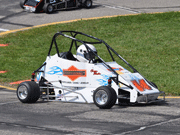
Midget (Quarter)

Midget race cars were introduced in the USA in the 1930s and raced on short 1/5 mile (0.32 km) dirt tracks. They were the original home-built race cars and their garage builders made use of every available automotive (and sometimes non-automotive) part they could use. Some cars were even powered by outboard boat motors.
Post-World War II, the Quarter midgets appeared much as their full-scale counterparts did, as home-builts. Since that time, the Quarter midgets have evolved into modern race cars parallel to the full-size Midgets.
The Quarter midgets are ¼ scale of the full size midget cars, and race on a ¼ scale track (1/20 mile or 80 m track). They use a scratch-built single seat chassis with a 1 or 2 cylinder mid-engine, rear drive layout and all-encompassing roll carge.
Racing is run in the USA and Canada on local tracks, with the largest racing participation in the USA.
| Power and Weight Stats | |
| Horsepower (Typical Range) | 6-16 |
| Race Weight (Typical Range) | 113-163 kg 250-360 lb |
Design and Construction
Build Your Own Quarter Midget Race Car
Knowledge Level
Due to the scratch-built nature of quarter midget cars, you should be knowledgeable in handling, chassis, suspension, powertrain, aerodynamic and safety design. These six major areas of the car design work as an integrated unit and the designer must have an understanding of how changes to one area affect the others. Much of the design work is iterative, meaning re-designing areas based on new changes to another area. After the iterations are completed, the design will be complete and optimized.
Understanding the handling and suspension of the live axle configuration and the springing/damping aspects are especially helpful in the design and tuning of quarter midget race cars.
Design Challenges
Weight Distribution: Because quarter midget cars run on oval tracks as opposed to road courses, they are generally configured to optimize counter-clockwise or left turns.
Suspension: Maximizing the compliance with the track is of key importance. Axle, wheel and tire weights (Unsprung weight) affect the compliance of the suspension, which in turn affects handling, so keeping all these components as light as possible while remaining sufficiently durable is an advantage.
The cars use stagger (larger outside tire) and offset (right side tire farther from the chassis than left side) to manage weight transfer, as well as ride height and springs/shocks. Adjustability in these areas must be designed into the car or tuning options will be very limited. At any given track, at any given race, the surface conditions might dictate tuning of these suspension components to provide more/less "bite" and tightening or loosening the rear of the car (understeer or oversteer).
The suspension link locations impact the chassis design.
Chassis: Providing openings to make internal components accessible for maintenance is also important.
Powertrain: Weight distribution is heavily impacted by engine position, especially on cars with as short a wheelbase as Quarter Midgets. Because the engine is located behind the driver, the weight distribution is far more rear-biased, which should be taken into account when designing the suspension's weight transfer characteristics.
Aerodynamic: The speeds reached by quarter midgets do not produce significant opportunities for drag reduction over what is considered stock bodywork.
Safety: Modern Quarter Midget cars require a full roll structure integral to the chassis, with a racing seat/harness. Side and rear bumper bars for impacts are also mandatory.
If you intend to race under a sanctioning body, always read and understand the regulations of your chosen racing class before designing or building any race vehicle.
Design Resources
Learn the basics about race cars and race car design from our free online knowledge series
Download our free race car design aids to assist you designing your race vehicle.
In-depth books and learning resources we recommend for midget car design.
Join our forum to ask and find answers to your midget car design/construction questions.
Construction Challenges
Ensuring the chassis is dimensionally accurate and straight is key. The use of a solid, flat and level build space is important. Jigs are often used in this case to ensure that structural tubing stays in alignment during welding/brazing.
The builder should have solid joining and metal working knowledge and skills when fabricating the chassis/rollcage/suspension. While mild steel (1018/1020) is very forgiving, some metals are best welded using a specific method (mig/tig) and some require heat treatments before and following welding to restore their toughness and strength.
Having sufficient space for the chassis and bodywork construction is important, as a cramped workshop can be difficult to work in.
The tools to fabricate the chassis and bodywork can add considerably to the cost of your project if you don't already have a workshop, but borrowing or renting items is also an option.
Build Costs
All components for an amateur-built Quarter midget car can be sourced from multiple quarter midget parts manufacturers, so there is a selection of available parts and prices to choose from.
Build Effort
If you choose to scratch-build your quarter midget, there will be a significant effort in design and construction, but considerably less than full scale race cars. There is however, an equally great satisfaction and sense of accomplishment at being one of the few people in the world who have built their own race car from the ground up! Many race car manufacturers also started this way, with the development of their own chassis leading them to build cars for others.
If building from a pre-fabricated kit, the effort will be far less and focused on assembly.
Racing Cost
Tires probably form the single largest consumable expense. Powertrain rebuilds and crash repairs will also be required periodically.
Transportation and Support Equipment
Can be loaded into the back of a pickup truck or onto a small trailer. Support equipment can be carried in the transport vehicle.

